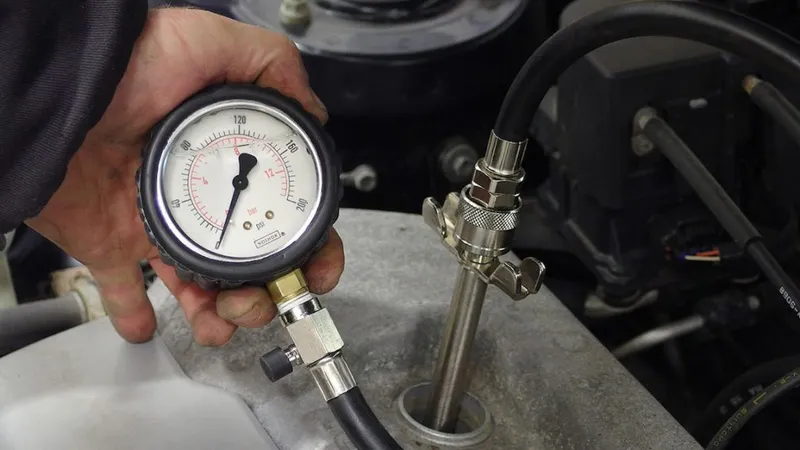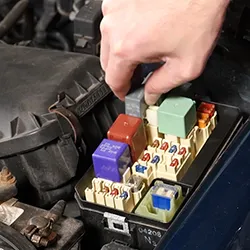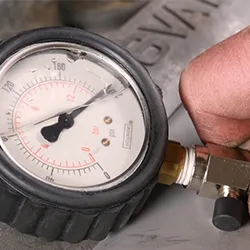🎁 FREE TIRE GAUGE with $100 Order • Code: GAUGE1125 • Learn More →
How to: Learn How to Test Engine Compression

Testing engine compression provides a snapshot of the health of your engine. In this video, we show you how to…
Engine compression = engine power. A simple equation even we non-engineers can understand. In this post, we’ll look at how to test engine compression.
Based on article by the INSIDE TRACK AMSOIL Blog October 5, 2020 and AMSOIL Tech Tips June 19, 2018 | links added by National Synthetics staff
What is engine compression?
First, however, let’s define our terms.
Engine compression refers to the pressure your engine generates inside the cylinders while it’s running.
How much pressure the engine produces and how well it converts that pressure into usable work influence your engine’s efficiency and power.How it all works and how wear and deposits can erode compression (i.e. horsepower) over time are interesting topics you can read more about here. But today, we’re talking about how to test engine compression.
For this example, I used my 1998 Toyota Corolla. Don’t laugh. I paid cash for it and it runs as smooth as a sewing machine. I also sought the help of Pat Burgraff, one of the techs in our Mechanical Lab.
Check out the video or the step-by-step directions to find out how to test engine compression.
How to Test Engine CompressionTotal Time: 30 minutes
Testing compression is a relatively quick and easy way to check the mechanical integrity or health of your engine. A compression test indicates the pressure each of the engine’s cylinders is generating. Excessively low compression in a cylinder is often a symptom of a larger problem, like worn piston rings or valves.
How to Test Engine CompressionTotal Time: 30 minutes
Testing compression is a relatively quick and easy way to check the mechanical integrity or health of your engine. A compression test indicates the pressure each of the engine’s cylinders is generating. Excessively low compression in a cylinder is often a symptom of a larger problem, like worn piston rings or valves.
Tools you need for testing compression
-
Compression tester (available at most parts stores)
-
Ratchet & extensions
-
Spark-plug socket
Ensure the engine doesn’t start
A compression test requires cranking – but not starting – the engine. To ensure it doesn’t start, remove the fuel-pump relay, if you can find it. You can

also disable the coil by disconnecting the primary power – or the smaller wires – from the coil. Disabling both systems ensures the engine doesn’t receive fuel or spark, meaning it won’t start and the engine won’t flood.
Start with the number-one cylinder. Remove the wire cap and use compressed air to remove any dust or dirt adjacent to the spark plug. Depending on your engine, you may need different lengths and types of extensions to reach the spark plug.
Remove the spark plug
Carefully back out the spark plug. This is a good time for a spark-plug inspection. Examine the electrodes. Ensure the edges are square and the plug looks to be in good condition. It’s a good time to change the plugs if necessary.
Attach the engine compression tester
Thread the compression tester into the cylinder, taking care to avoid cross-threading. Use a compression tester with an extension if possible. An extension allows you to better access difficult-to-reach spark-plug holes. Connect the compression gauge to the extension.

Crank the engine
Have a helper turn over the engine while you watch the needle on the compression gauge. Continue cranking the engine until the needle plateaus, meaning the needle stops climbing. Note the reading on the gauge. Repeat the process for the remaining cylinders. Remember to note compression for each cylinder.
Compare results
After you’ve tested each cylinder, compare the highest reading with the lowest. A good rule of thumb states they should be within 10 percent of each other. If they are, your engine is healthy and all cylinders are contributing to making power and moving your vehicle down the road.
If psi in one cylinder is significantly lower than the others, for example 20 or 30 psi, it indicates a mechanical problem that requires further diagnosis.
Record results
Write down the results for each cylinder so you can compare and identify if compression is too low in one cylinder.
What’s considered “normal” engine compression?
Here’s where things grow murky. “Good” compression depends on the engine. Unfortunately, engines don’t come with their proper compression stamped on the outside.
But a good rule of thumb says that each cylinder in a mechanically sound engine should have compression of 130 psi or higher.While I’ve seen some people claim 100 psi is sufficient, the gearheads and other sources I’ve consulted consider that too low.
In addition, you want consistency from one reading to the next.
Again, a good rule of thumb is no more than 10 percent variation between any of the cylinders.That’s not to say 15 or 20 percent variation in one cylinder means your engine is junk. But a good, healthy engine should demonstrate minimal variation. Note: If psi in one cylinder is significantly lower than the others, for example 20 or 30 psi, it indicates a mechanical problem that requires further diagnosis.
My trusty Corolla nailed the test, making between 165-175 psi in each cylinder.
A quick test if one cylinder has low compression
If one cylinder has low compression, try pouring about a teaspoon of oil into the spark-plug hole and retesting. If compression increases, it’s likely the rings are stuck or worn. The oil acts as a seal and helps close the gap between the rings and the cylinder wall through which the cylinder is losing pressure.
If that doesn’t work, it’s possible the valves or valve seals are worn.
If you suspect stuck rings, try an engine flush designed to clean deposits, such as AMSOIL Engine and Transmission Flush.
BUY ENGINE & TRANSMISSION FLUSH
You can also try a fuel additive that cleans pistons, like AMSOIL P.i.
BUY AMSOIL P.I.®
Word to the wise: you may illuminate your check engine light performing this test, as I did. It went off by itself after driving a few miles, though.
Updated. Originally published March 13, 2017.*All trademarked names and images are the property of their respective owners and may be registered marks in some countries. No affiliation or endorsement claim, express or implied, is made by their use.
Do you want to become an AMSOIL Preferred Customer?
Let’s do this. Simple as can be!
Become an AMSOIL Preferred Customer Today!
BUY AMSOIL PRODUCTS WITH EASE!
At National Synthetics we’ve been providing superior AMSOIL Products & services to our customers for over a decade.
Please reach out to us if we can answer any questions or help you with AMSOIL products.
Protect Your Engine with AMSOIL
Experience the difference premium synthetic lubricants make. Shop with confidence through your authorized AMSOIL dealer.
Browse AMSOIL Products












